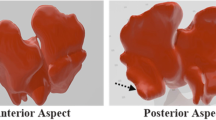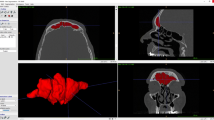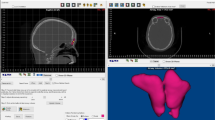Abstract
Analysis of the frontal sinus is an important tool in personal identification. Cone beam-computed tomography (CBCT) is also progressively replacing conventional radiography and multi-slice computed tomography (MSCT) in human identification. The aim of this study is to develop a reproducible technique and measurements from 3D reconstructions obtained with CBCT, for use in human identification. CBCT from 150 patients (91 female, 59 male), aged between 15 and 78 years, was analysed with the specific software program MIMICS 11.11 (Materialise N.V., Leuven, Belgium). Corresponding 3D volumes were generated and maximal dimensions along 3 directions (x, y, z), X M, Y M, Z M (in mm), total volume area (in mm3), V t, and total surface (in mm2), S t, were calculated. Correlation analysis showed that sinus surfaces were strongly correlated with their volume (r = 0.976). Frontal sinuses were separate in 21 subjects (14 %), fused in 67 (44.6 %) and found on only one side (unilateral) in 9 (6 %). A Prominent Middle of Fused Sinus (PMS) was found in 53 subjects (35.3 %). The intra- (0.963–0.999) and inter-observer variability (0.973–0.999) showed a great agreement and a substantial homogeneity of evaluation.




Similar content being viewed by others
References
David MP, Saxena R (2010) Use of frontal sinus and nasal septum patterns as an aid in personal identification: a digital radiographic pilot study. J Forensic Dent Sci 2:77–80
Kanchan T, Krishan K, Menezes RG, Suresh Kumar Shetty B, Lobo SW (2010) Frontal sinus radiographs-a useful means of identification. J Forensic Leg Med 17:223–224
Tatlisumak E, Asirdizer M, Sunay Yavuz M (2011) Usability of CT Images of frontal sinus in forensic personal identification. In: Homma N (ed) Theory and applications of CT imaging and analysis. InTech, Rijeka, pp 257–268
Abraham J, Champod C, Lennard C, Roux C (2013) Spatial analysis of corresponding fingerprint features from match and close non-match populations. Forensic Sci Int 230(1–3):87–98
Schuliar Y, Knudsen PJ (2012) Role of forensic pathologists in mass disasters. Forensic Sci Med Pathol 8:164–173
Schwark T, Heinrich A, Von Wurmb-Schwark N (2011) Genetic identification of highly putrefied bodies using DNA from soft tissues. Int J Legal Med 125:891–894
Rios L, García-Rubio A, Martínez B, Alonso A, Puente J (2012) Identification process in mass graves from the Spanish Civil War II. Forensic Sci Int 219:e4–e9
Ishii M, Yayama K, Motani H, Sakuma A, Yasjima D, Hayakawa M, Yamamoto S, Iwase H (2011) Application of superimposition-based personal identification using skull computed tomography images. J Forensic Sci 56:960–966
Berketa JW (2014) Maximizing postmortem oral-facial data to assist identification following severe incineration. Forensic Sci Med Path 10(2):208–216
Patil N, Karjodkar FR, Sontakke S, Sansare K, Salvi R (2012) Uniqueness of radiographic patterns of the frontal sinus for personal identification. Imaging Sci Den 42:213–217
McLaughlin RB Jr, Rehl RM, Lanza DC (2001) Clinically relevant frontal sinus anatomy and physiology. Otolaryng Clin N Am 34:1–22
Seiden AM (2005) Frontal headache. In: Kountakis SE, Senior BA, Draf W (eds) The frontal sinus. Springer, Berlin, pp 115–126
Allen BC (1961) Applied anatomy of paranasal sinuses. J Am Osteopath Assoc 60:978
Kirk NJ, Wood RE, Goldstein M (2002) Skeletal identification using the frontal sinus region: a retrospective study of 39 cases. J Forensic Sci 47:318–323
Cox M, Malcolm M, Fairgrieve SI (2009) A new digital method for the objective comparison of frontal sinuses for identification. J Forensic Sci 54:761–772
Nambiar P, Naidu MD, Subramaniam K (1999) Anatomical variability of the frontal sinuses and their application in forensic identification. Clin Anat 12:16–19
Wallis A, Donal PJ (1988) Frontal sinus fractures: a review of 72 cases. Laryngoscope 98:593–598
Quatrehomme G, Fronty P, Sapanet M, Grévin G, Bailet P, Ollier A (1996) Identification by frontal sinus pattern in forensic anthropology. Forensic Sci Int 83:147–153
Yoshino M, Miyasaka S, Sato H, Seta S (1987) Classification system of frontal sinus patterns by radiography. Its application to identification of unknown skeletal remains. Forensic Sci Int 34:289–299
Christensen AM (2004) The impact of Daubert: implications for testimony and research in forensic anthropology (and the use of frontal sinuses in personal identification). J Forensic Sci 49(3):1–4
Campobasso CP, Dell’erba AS, Belviso M, Di Vella G (2007) Craniofacial identification by comparison of antemortem and postmortem radiographs: two case reports dealing with burnt bodies. Am J Forensic Med Pathol 2:182–186
Ribeiro Fde A (2000) Standardized measurements of radiographic films of the frontal sinuses: an aid to identifying unknown persons. Ear Nose Throat J 79:26–33
Tatlisumak E, Ovali GY, Aslan A, Asirdizer M, Zeyfeoglu Y, Tarhan S (2007) Identification of unknown bodies by using CT images of frontal sinus. Forensic Sci Int 166:42–48
Cameriere R, Ferrante L, Molleson T, Brown B (2008) Frontal sinus accuracy in identification as measured by false positives in kin groups. J Forensic Sci 53:1280–1282
Christensen AM (2005) Assessing the variation in individual frontal sinus outlines. Am J Phys Anthropol 127:291–295
Kim DI, Lee UY, Park SO, Kwak DS, Han SH (2012) Identification using frontal sinus by three-dimensional reconstruction from computed tomography. J Forensic Sci 58(19):5–12
Jackowski C, Wyss M, Persson A, Classens M, Thali MJ, Lussi A (2008) Ultra-high-resolution dual-source CT for forensic dental visualization-discrimination of ceramic and composite fillings. Int J Legal Med 122(43):301–307
Carvalho SPM, Alves da Silva RH, Lopes-Júnior C, Peres AS (2009) Use of images for human identification in forensic dentistry. Radiol Bras 42(2):125–130
Uthman AT, Al-Rawi NH, Al-Naaimi AS, Tawfeeq AS, Suhail EH (2010) Evaluation of frontal sinus and skull measurements using spiral CT scanning: an aid in unknown person identification. Forensic Sci Int 197(124):e1–e7
Cappabianca S, Perillo L, Esposito V, Iaselli F, Tufano G, Thanassoulas TG et al (2013) A computed tomography-based comparative cephalometric analysis of the Italian craniofacial pattern through 2,700 years. Radiol Med 118(2):276–290
Reichs KJ (1993) Quantified comparison of frontal sinus patterns by means of computed tomography. Forensic Sci Int 61:141–168
Miracle AC, Mukherji SK (2009) Cone-beam CT of the head and neck, Part 2: clinical applications. Am J Neuroradiol 30:1285–1292
Sarment D, Christensen AM (2014) The use of cone beam computed tomography in forensic radiology. J Forensic Rad Imag 2(4):173–181
Cameriere R, Ferrante L, Mirtella D, Rollo FU, Cingolani M (2005) Frontal sinuses for identification: quality of classifications, possible error and potential corrections. J Forensic Sci 50(4):770–773
Ferrante L, Cameriere R (2009) Statistical methods to assess the reliability of measurements in the procedures for forensic age estimation. Int J Legal Med 123:277–283
Shrout PE, Fleiss JL (1979) Intra-class correlations: uses in assessing rater reliability. Psychol Bull 2:420–428
Kapila S, Conley RS, Harrell WE Jr (2011) The current status of cone beam computed tomography imaging in orthodontics. Dentomaxillofac Rad 40:24–34
Besana JL, Rogers TL (2010) Personal identification using the frontal sinus. J Forensic Sci 55:584–589
Levine HL, Clemente MP (2003) Surgical anatomy of the paranasal sinus. In: Clemente MP (ed) Sinus surgery: endoscopic and microscopic approaches. Thierne, Stuttgart, pp 1–55
Shah RK, Dhingra JK, Carter BL, Rebeiz EE (2003) Paranasal sinus development: a radiographic study. Laryngoscope 113:205–209
Lee HK, Kwon KH, Kim KJ, Kang SM, Moon GJ (1985) A study on the classification of frontal sinuses and distributions using simple AP skull radiographies. J Soonchunhyang Univ 8(4):481–485
Acknowledgments
The authors would like to thank the staff of the Unit of Orthodontics and Pediatric Dentistry, University of Milan (Italy) for their assistance on this project, and also Ms. Gabriel Walton for editing the English text. Thanks also to the editor and the reviewers for helpful comments that have improved this paper.
Conflict of interest
The authors declare that they have no conflict of interest.
Ethical standards
All procedures performed in studies involving human participants were in accordance with the ethical standards of the institutional and/or national research committee and with the 1964 Helsinki declaration and its later amendments or comparable ethical standards.
Informed consent
Informed consent was obtained from all individual participants included in the study.
Author information
Authors and Affiliations
Corresponding author
Rights and permissions
About this article
Cite this article
Cossellu, G., De Luca, S., Biagi, R. et al. Reliability of frontal sinus by cone beam-computed tomography (CBCT) for individual identification. Radiol med 120, 1130–1136 (2015). https://doi.org/10.1007/s11547-015-0552-y
Received:
Accepted:
Published:
Issue Date:
DOI: https://doi.org/10.1007/s11547-015-0552-y




